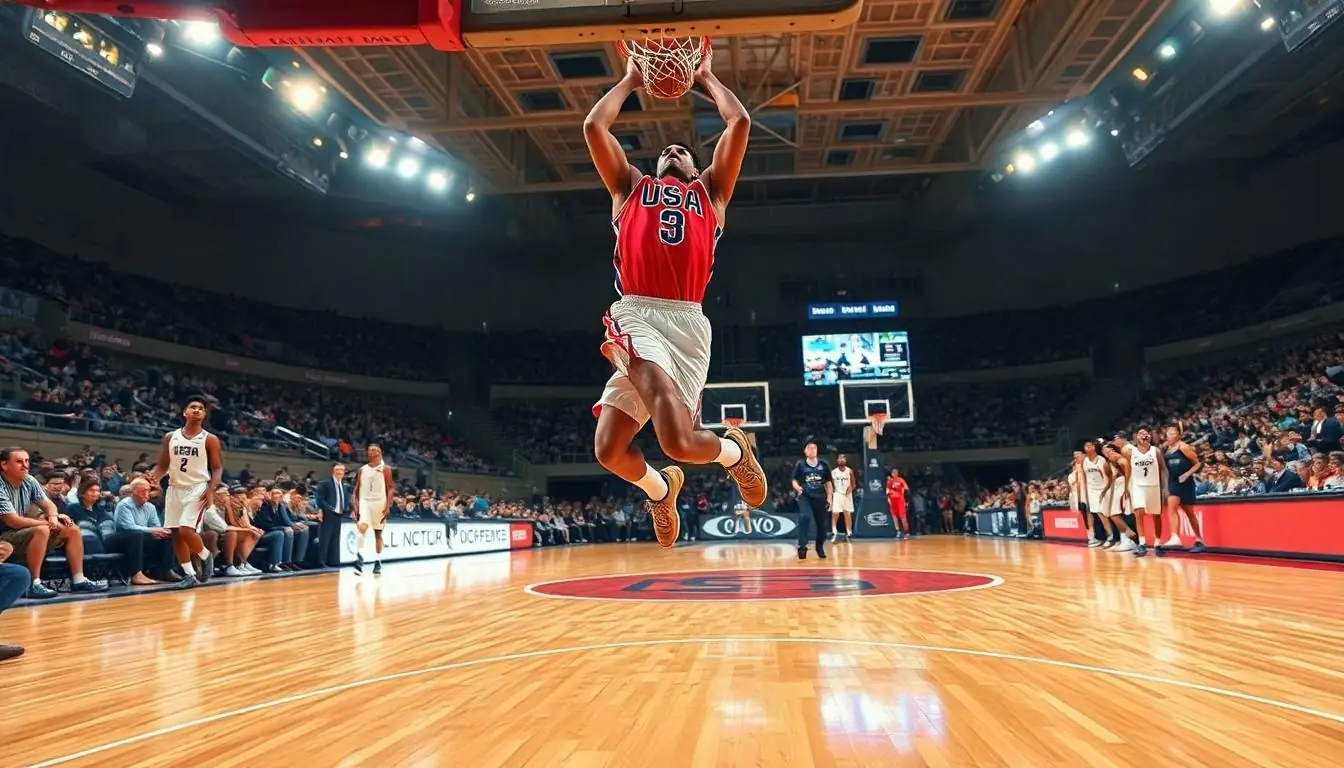In the world of basketball, it’s not just about dribbling or shooting; it’s about speaking the lingo. Imagine trying to impress your friends with your basketball skills while fumbling through terms like “alley-oop” or “full-court press.” It’s like trying to order a fancy coffee without knowing the difference between a macchiato and a frappuccino.
Table of Contents
ToggleImportance Of Basketball Vocabulary
Understanding basketball vocabulary enhances engagement with the sport. Familiarity with terms like “alley-oop” or “full-court press” allows players to communicate effectively during games. Knowledge of this lingo impresses teammates and coaches. It also facilitates insightful discussions among fans.
Players gain a competitive edge by grasping tactical phrases. Terms like “pick and roll” or “fast break” describe game strategies. Recognizing these concepts improves on-court decision-making. Moreover, fans appreciate the game more when they comprehend the terminology.
Beginners often experience confusion without basic knowledge. Familiarizing oneself with common terms makes learning easier. A strong vocabulary builds confidence while playing or watching games. Coaches rely on precise communication to convey strategies, making terminology essential in training.
Basketball broadcasts frequently use jargon that enhances viewer experience. Viewers who understand the language connect better with the action. They enjoy a richer experience while following their favorite teams. Engaging with players and commentators becomes more rewarding when fans can follow along.
Players who master vocabulary can articulate their thoughts during interviews. This skill enhances their overall marketability. A solid grasp of basketball terms can lead to opportunities in coaching or sports commentary. For these reasons, prioritizing learning basketball vocabulary proves beneficial.
Common Basketball Terms

Understanding basketball terminology enhances both play and conversation. Familiarity with key terms empowers players and fans alike.
Offensive Terms
“Alley-oop” signifies a play where one player scores after receiving a high pass. “Fast break” describes a quick transition from defense to offense, focusing on speed and efficiency. “Pick and roll” involves a screen set by a player to create space for a teammate. “Three-pointer” refers to a shot made from beyond the arc, worth three points. “Iso” or isolation play focuses on giving one player space to create their own shot. Mastering these offensive terms is crucial for effective communication and strategic execution.
Defensive Terms
“Full-court press” describes an intense defense applied across the entire court to pressure the offense. “Zone defense” involves players covering specific areas instead of marking individual opponents. “Man-to-man defense” entails each defender guarding a specific offensive player. “Shot block” indicates the action of deflecting or stopping an opponent’s shot. “Rebound” emphasizes retrieving the ball after a missed shot, vital for possession. Understanding these defensive terms enables better coordination and effectiveness on the court.
Basketball Vocabulary By Skill Level
Understanding basketball vocabulary enhances engagement and allows players and fans to communicate effectively. Familiarity with terms improves on-court performance and enriches discussions about the sport.
Beginner Vocabulary
Basic basketball terms lay the foundation for deeper understanding. Common words include “ball,” referring to the primary object of play. “Dribble” defines the action of bouncing the ball while running. “Pass” means distributing the ball to a teammate. “Shoot” indicates attempting to score by putting the ball in the basket. “Court” denotes the playing area. Recognizing these terms provides beginners with essential knowledge to follow the game and participate confidently.
Intermediate Vocabulary
Intermediate terms introduce tactical concepts that enhance gameplay awareness. “Pick and roll” describes a play involving a screen set by an offensive player. “Fast break” signifies a quick offensive play following a defensive rebound. “Three-pointer” refers to a shot taken from beyond the arc worth three points. “Iso,” short for isolation, indicates a strategy where a player creates a one-on-one opportunity. Familiarity with these terms allows players to understand more complex strategies and improve on-court communication.
Advanced Vocabulary
Advanced vocabulary encompasses complex strategies and specialized terminology. “Box-and-one” describes a defensive strategy combining man-to-man and zone defenses. “Full-court press” denotes aggressive defensive tactics applied across the entire court. “Alley-oop” refers to a play where a player scores off a pass in mid-air. “Transition defense” involves quickly shifting from offense to defense after a turnover. Mastering this vocabulary aids in understanding high-level play and tactical discussions among players and coaches.
Incorporating Basketball Vocabulary In Practice
Incorporating basketball vocabulary into practice enhances team communication during drills and games. Coaches often emphasize the importance of using terms like “pick and roll” when executing plays. Players gain a better understanding of strategies by discussing “fast breaks” and how to capitalize on them effectively.
Drills can integrate offensive and defensive vocabulary. Running through exercises that focus on “man-to-man defense” or “zone defense” provides clarity on spatial responsibilities. By articulating these terms in practice, players reinforce their understanding of each concept.
During scrimmages, using common terms promotes a fast-paced learning environment. When teammates call out “alley-oop,” it helps everyone anticipate the play. Building familiarity with phrases such as “three-pointer” and “rebound” ensures quick decision-making on the court.
Another effective strategy involves reviewing game footage and discussing terminology in context. Players learn to identify moments when “full-court press” might succeed versus when to utilize “transition defense.” This analysis deepens their comprehension of strategy and game flow.
In team meetings, prioritizing vocabulary discussions encourages a culture of learning. Introducing new terms like “iso” while explaining its significance in various plays broadens players’ knowledge. Players who confidently use terms enhance their marketability and effectively communicate with coaches and media.
Encouraging players to express their thoughts with specific language helps develop their basketball IQ. Mastery of terminology not only aids in gameplay but also boosts confidence in performance. Engaging with basketball vocabulary becomes a crucial component of practice, fostering team dynamics and individual growth.
Mastering basketball vocabulary is key to thriving in the sport. It not only enhances on-court performance but also enriches the overall experience for players and fans alike. By understanding essential terms and their nuances, individuals can communicate effectively and make informed decisions during games.
As players grow in their knowledge of terminology, they gain confidence and improve their strategic thinking. This fluency in basketball lingo opens doors to opportunities in coaching and commentary, furthering their engagement with the sport.
Embracing this vocabulary fosters a deeper connection to basketball, transforming both practice and competition into more rewarding experiences.




